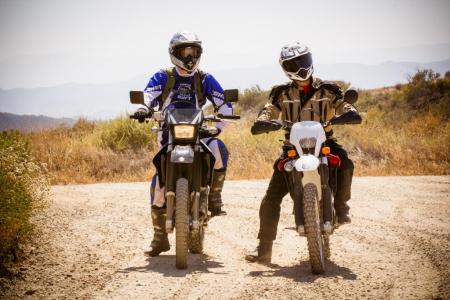2012 Dual-Sport Shootout - Video - Motorcycle.com
Dual-sport, aka dual-purpose motorcycles, have it rough. Designing a bike to traverse both street and dirt environments well enough to please the moto masses is bound to lead to disappointment somewhere. By way of their split functions, DS motorcycles have to compromise. Often a dual-sport sacrifices superior street manners in order to achieve at least a modicum of off-road prowess, or vice-versa.
Despite few changes in the DS segment in the past few model years, we decided to sample some current DS offerings to see if there is a do-it-all bike that doesn’t suck … the fun out of one type of riding or the other.
250cc Upper Classmen
Rather than gravitating to the usual suspects like Kawasaki’s KLR650 or a BMW GS model, this time we wanted to look at what was available in the small-bore D-S class. But this category is deceptive, as the offerings vary wildly.
On one end of the 250 spectrum we have the likes of Honda’s CRF230L, Kawasaki’s KLX250S and Yamaha’s XT250. While these bikes essentially fit the displacement range, they are otherwise driven by a price point rather than built to a high-performance standard.
When we compared this trio in 2008 each was priced below $5000. Four years later only the XT has crested that mark, retailing for $5190 in 2012. These 250s keep MSRPs low by sourcing components that, while perfectly functional, lack sophistication and a performance edge.
At the opposite end of the 250 range we have the likes of Husqvarna’s TE250 and Yamaha’s WR250R. These are the pro-am athletes of the class; their rev-happy engines, suspension and chassis are either derived from the manufacturer’s racing efforts, or selected for being some of the best equipment available while remaining affordable for the consumer.
Authorized Cheater
We then decided to prioritize MSRP to see what DS machines might make a price-conscious alternative to the $7600 Husqvarna TE250 and $6690 Yamaha WR250R, yet remain reasonably close to the 250cc displacement. At $6199, Suzuki’s long-running DR-Z400 made the cut.
Now, before the Team Green loyalists start storming the gates to remind us that the KLR650 is only $100 more than the Suzuki yet offers 250cc more get-up-and-go, rest assured the Killer remains a bike much loved at this moto-ezine – we’ve reviewed the dickens out of it. But the Kawi weighs 115 pounds more than the Suzuki when comparing curb weights.
On the street this weight penalty might not factor in as much, but when bombing down rutted Jeep-type trails, or picking around slow-speed technical terrain, the Kawi’s additional weight is a serious demerit. Sorry, KLR lovers, but this is one dual-sport comparison on Motorcycle.com the KLR won’t get to participate in.
The Dirty Trio Is Complete. Not!
We were eager to see how the battle between the Yamaha and Husky would shake out, while the wildcard DR-Z held the potential to throw a wrench in the works, possibly proving itself a serious contender despite lacking serious off-road chops.
Alas, we’ll never know which of these of three might’ve emerged victorious as our top pick in the lightweight dual-sport category. Despite much planning and anticipation, due to circumstances beyond our control, we gots no Yamaha WR250R. But there’s a small reprieve to our frustrations.
Since we’ve reviewed the WR250R and its mechanically similar WR250X supermoto brother several times in the past few years, we have a few points of reference that suggest how the WR might have performed if we’d had one to test. And spec-sheet jockeys can take some solace in our comparative spec table that includes the WR250R. Otherwise, our 250cc Dual-Sport Shootout is unfortunately now more aptly titled as the Comparison of the Obvious...
More by Pete Brissette































Comments
Join the conversation